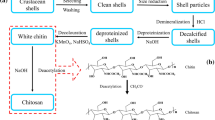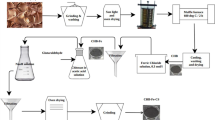Abstract
The 3-chloro-2 hydroxypropyltrimethyl ammonium chloride was successfully introduced into the β-cyclodextrin-modified chitosan to create the multicomponent adsorbent O-HTACC-g-CD. The structure of sorbent was characterized by Fourier transform infrared spectroscopy, X-ray diffraction, thermogravimetric analysis, and scanning electron microscopy. The adsorption capacity of O-HTACC-g-CD toward phenol was investigated as a function of pH, temperature, contact time as well as adsorbent dosage. The Box-Behnken response surface methodology was employed to optimize the effects of experimental parameters including adsorbent dose, pH, and time on the adsorption of phenol at 298.15 K. The obtained optimal values for adsorbent dose, pH, and time were 0.06 g, 6, and 200 min, respectively. The obtained experimental data follows the pseudo-second-order kinetic and Langmuir model. The thermodynamic parameters such as free energy change, enthalpy change, and entropy change were calculated, revealing that adsorption of phenol on O-HTACC-g-CD is a spontaneous and exothermic process. The prepared O-HTACC-g-CD displayed high adsorption capacity (39.98 mg g−1) and excellent removal rate (96%) for phenol from the aqueous solution at 288.15 K. The gained removal rates of chemical oxygen demand (CODCr) were in the range of 60.6–61.2%. Considerable results of sorption could be attributed to the multicomponent structure of the adsorbent with more active sites including the cavities, amino, and carboxyl functional groups which provided better sites for the phenolic pollutant to adsorb on the adsorbent via Van der Waals force, hydrogen bond, and the inclusion effect. Therefore, the results obtained strongly suggest that O-HTACC-g-CD could be an effective adsorbent for the removal of phenol and CODcr from drilling wastewater.








Similar content being viewed by others
References
Achak M, Hafidi A, Ouazzani N, Sayadi S, Mandi L (2009) Low cost biosorbent “banana peel” for the removal of phenolic compounds from olive mill wastewater: kinetic and equilibrium studies. J Hazard Mater 166:117–125. https://doi.org/10.1016/j.jhazmat.2008.11.036
Beheshti H, Irani M, Hosseini L, Rahimi A, Aliabadi M (2016) Removal of Cr (VI) from aqueous solutions using chitosan/MWCNT/Fe3O4 composite nanofibers-batch and column studies. Chem Eng J 284:557–564. https://doi.org/10.1016/j.cej.2015.08.158
Busca G, Berardinelli S, Resini C, Arrighi L (2008) Technologies for the removal of phenol from fluid streams: A short review of recent developments. J Hazard Mater 160:265–288. https://doi.org/10.1016/j.jhazmat.2008.03.045
Campos EVR, Oliveira JL, Fraceto LF (2017) Poly(ethylene glycol) and cyclodextrin-grafted chitosan: from methodologies to preparation and potential biotechnological applications. Front Chem 5:15. https://doi.org/10.3389/fchem.2017.00093
Chen WJ, Zou CJ, Li XK, Li L (2016) The treatment of phenolic contaminants from shale gas drilling wastewater: a comparison with UV-Fenton and modified UV-Fenton processes at neutral pH. RSC Adv 6:90682–90689. https://doi.org/10.1039/c6ra18662a
Crini GJBT (2006) Non-conventional low-cost adsorbents for dye removal: a review. 97: 1061-1085
Du Z, Deng S, Bei Y, Huang Q, Wang B, Huang J, Yu G (2014) Adsorption behavior and mechanism of perfluorinated compounds on various adsorbents—a review. J Hazard Mater 274:443–454. https://doi.org/10.1016/j.jhazmat.2014.04.038
Elgadir MA, Uddin MS, Ferdosh S, Adam A, Chowdhury AJK, Sarker MZI (2015) Impact of chitosan composites and chitosan nanoparticle composites on various drug delivery systems: a review. J Food Drug Anal 23:619–629. https://doi.org/10.1016/j.jfda.2014.10.008
Eslaminejad T, Nematollahi-Mahani SN, Ansari M (2016) Cationic beta-cyclodextrin-chitosan conjugates as potential carrier for pmCherry-C1 gene delivery. Mol Biotechnol 58:287–298. https://doi.org/10.1007/s12033-016-9927-0
Fan L, Li M, Lv Z, Sun M, Luo C, Lu F, Qiu H (2012a) Fabrication of magnetic chitosan nanoparticles grafted with β-cyclodextrin as effective adsorbents toward hydroquinol. Colloids Surf B: Biointerfaces 95:42–49. https://doi.org/10.1016/j.colsurfb.2012.02.007
Fan L, Zhang Y, Luo C, Lu F, Qiu H, Sun M (2012b) Synthesis and characterization of magnetic beta-cyclodextrin-chitosan nanoparticles as nano-adsorbents for removal of methyl blue. Int J Biol Macromol 50:444–450. https://doi.org/10.1016/j.ijbiomac.2011.12.016
Fan LL, Li M, Lv Z, Sun M, Luo CN, Lu FG, Qiu HM (2012c) Fabrication of magnetic chitosan nanoparticles grafted with beta-cyclodextrin as effective adsorbents toward hydroquinol. Colloids Surf B Biointerfaces 95:42–49. https://doi.org/10.1016/j.colsurfb.2012.02.007
Febrianto J, Kosasih AN, Sunarso J, Ju Y-H, Indraswati N, Ismadji S (2009) Equilibrium and kinetic studies in adsorption of heavy metals using biosorbent: a summary of recent studies. J Hazard Mater 162:616–645. https://doi.org/10.1016/j.jhazmat.2008.06.042
Gu X, Qiu F, Zhou X, Qi J, Zhou Y, Yang D, Guo Q, Guo X (2013) Synthesis and application of terpolymer scale inhibitor in the presence of β-cyclodextrins. J Pet Sci Eng 109:177–186. https://doi.org/10.1016/j.petrol.2013.08.021
Guan W, Tian S (2017) The modified chitosan for dyeing wastewater treatment via adsorption and flocculation. Sci Adv Mater 9:1603–1609. https://doi.org/10.1166/sam.2017.3156
Guo YJ, Guo SJ, Ren JT, Zhai YM, Dong SJ, Wang EK (2010) Cyclodextrin functionalized graphene nanosheets with high supramolecular recognition capability: synthesis and host-guest inclusion for enhanced electrochemical performance. ACS Nano 4:4001–4010. https://doi.org/10.1021/nn100939n
Ho Y-S (2004) Selection of optimum sorption isotherm. Carbon 42:2115–2116. https://doi.org/10.1016/j.carbon.2004.03.019
Hu C, Deng Y, Hu H, Duan Y, Zhai K (2016) Adsorption and intercalation of low and medium molar mass chitosans on/in the sodium montmorillonite. Int J Biol Macromol 92:1191–1196. https://doi.org/10.1016/j.ijbiomac.2016.08.007
Izawa H, Haraya YT, Kawakami K (2017) Cyclodextrin-grafted chitosans for pharmaceutical applications. Trends Glycosci Glycotechnol 29:E93–E98. https://doi.org/10.4052/tigg.1620.1E
Ji J, Wang L, Yu HJ, Chen YS, Zhao YL, Zhang HT, Amer WA, Sun YB, Huang L, Saleem M (2014) Chemical modifications of chitosan and its applications. Polym-Plast Technol Eng 53:1494–1505. https://doi.org/10.1080/03602559.2014.909486
Jin L, He DD, Wei M (2011) Selective adsorption of phenol and nitrobenzene by beta-cyclodextrin-intercalated layered double hydroxide: equilibrium and kinetic study. Chem Eng Technol 34:1559–1566. https://doi.org/10.1002/ceat.201000319
Johns J, Rao V (2008) Characterization of natural rubber latex/chitosan blends. Int J Polym Anal Charact 13:280–291. https://doi.org/10.1080/10236660802190104
Kumar KV, Porkodi K (2008) Comments on “Removal of Congo red from aqueous solution by anilinepropylsilica xerogel” by Pavan FA, Dias SLP, Lima EC, Benvenutti EV. Dyes and Pigments 2008;76 : 64-9. Dyes Pigments 77:481–482. https://doi.org/10.1016/j.dyepig.2007.01.010
Langmuir I (1933) Surface Chemistry. Chem Rev 13:147–191. https://doi.org/10.1021/cr60045a001
Li JM, Meng XG, Hu CW, Du J (2009) Adsorption of phenol, p-chlorophenol and p-nitrophenol onto functional chitosan. Bioresour Technol 100:1168–1173. https://doi.org/10.1016/j.biortech.2008.09.015
Lin S-H, Juang R-S (2009) Adsorption of phenol and its derivatives from water using synthetic resins and low-cost natural adsorbents: a review. J Environ Manag 90:1336–1349. https://doi.org/10.1016/j.jenvman.2008.09.003
Liu Y, Chen J, Chen M, Zhang B, Wu D, Cheng Q (2015) Adsorption characteristics and mechanism of sewage sludge-derived adsorbent for removing sulfonated methyl phenol resin in wastewater. RSC Adv 5:76160–76169. https://doi.org/10.1039/c5ra17125c
Lu RH, Mu B, Zhang HY, Guo SH (2008) Treatment of drilling wastewater using a weakly basic resin. Pet Sci 5:275–279. https://doi.org/10.1007/s12182-008-0045-x
Ma Y, Gao NY, Chu WH, Li C (2013) Removal of phenol by powdered activated carbon adsorption. Front Environ Sci Eng 7:158–165. https://doi.org/10.1007/s11783-012-0479-7
Mojoudi N, Mirghaffari N, Soleimani M, Shariatmadari H, Belver C, Bedia J (2019) Phenol adsorption on high microporous activated carbons prepared from oily sludge: equilibrium, kinetic and thermodynamic studies. Sci Rep 9:19352. https://doi.org/10.1038/s41598-019-55794-4
Nwabue FI, Itumoh EJ (2019) Adsorption isotherm and kinetic modeling of a novel procedure for physical modification of silica gel using aqueous solutions of 4,4'-(1,2-ethanediyldinitrilo)bis-(2-pentanone) for preconcentration of Ni(II) ion. Sep Sci Technol. https://doi.org/10.1080/01496395.2019.1659821
Ou C-Y, Li S-D, Li C-P, Zhang C-H, Yang L, Chen C-P (2008) Effect of cupric ion on thermal degradation of chitosan. J Appl Polym Sci 109:957–962. https://doi.org/10.1002/app.28001
Peñas FJ, Romo A, Isasi JR, San José MJ, Alvarez S (2019) Kinetic modeling of sorption–desorption cycles for phenol removal with a cyclodextrin polymer. J Ind Eng Chem 75:93–99. https://doi.org/10.1016/j.jiec.2019.03.002
Salari M, Dehghani MH, Azari A, Motevalli MD, Shabanloo A, Ali I (2019) High performance removal of phenol from aqueous solution by magnetic chitosan based on response surface methodology and genetic algorithm. J Mol Liq 285:146–157. https://doi.org/10.1016/j.molliq.2019.04.065
Sharma S, Rajesh N (2017) Expeditious preparation of β-cyclodextrin grafted chitosan using microwave radiation for the enhanced palladium adsorption from aqueous waste and an industrial catalyst. J Environ Chem Eng 5:1927–1935. https://doi.org/10.1016/j.jece.2017.03.015
Sikder MT, Mihara Y, Islam MS, Saito T, Tanaka S, Kurasaki M (2014) Preparation and characterization of chitosan–caboxymethyl-β-cyclodextrin entrapped nanozero-valent iron composite for Cu (II) and Cr (IV) removal from wastewater. Chem Eng J 236:378–387. https://doi.org/10.1016/j.cej.2013.09.093
Song G, Yu Y, Liu T, Xi H, Zhou Y (2019) Performance of microaeration hydrolytic acidification process in the pretreatment of 2-butenal manufacture wastewater. J Hazard Mater 369:465–473. https://doi.org/10.1016/j.jhazmat.2019.02.034
Tan IAW, Ahmad AL, Hameed BH (2008) Adsorption of basic dye on high-surface-area activated carbon prepared from coconut husk: equilibrium, kinetic and thermodynamic studies. J Hazard Mater 154:337–346. https://doi.org/10.1016/j.jhazmat.2007.10.031
Vimonses V, Lei SM, Jin B, Chowd CWK, Saint C (2009) Kinetic study and equilibrium isotherm analysis of Congo Red adsorption by clay materials. Chem Eng J 148:354–364. https://doi.org/10.1016/j.cej.2008.09.009
Wang Z-K, Hu Q-L (2010) Chitosan rods reinforced by N-carboxyl propionyl chitosan sodium. Acta Phys -Chim Sin 26:2053–2056. https://doi.org/10.3866/pku.Whxb20100711
Wang QH, Zhang J, Shi DL, Du M (2015) Synthesis, Characterization and inhibition performance of vanillin-modified chitosan quaternary ammonium salts for Q235 steel corrosion in HCl solution. J Surfactant Deterg 18:825–835. https://doi.org/10.1007/s11743-015-1717-3
Wang A, Zhu Q, Xing Z (2019) Design and synthesis of a calcium modified quaternized chitosan hollow sphere for efficient adsorption of SDBS. J Hazard Mater 369:342–352. https://doi.org/10.1016/j.jhazmat.2019.02.047
Yan X, Zhang X, Li Q (2018) Preparation and characterization of CS/β-CD/Nano-ZnO composite porous membrane optimized by Box-Behnken for the adsorption of Congo red. Environ Sci Pollut Res 25:22244–22258. https://doi.org/10.1007/s11356-018-2110-3
Zou C, Liu Y, Yan X, Qin Y, Wang M, Zhou L (2014) Synthesis of bridged β-cyclodextrin–polyethylene glycol and evaluation of its inhibition performance in oilfield wastewater. Mater Chem Phys 147:521–527. https://doi.org/10.1016/j.matchemphys.2014.05.025
Funding
This work was funded by the National Natural Science Foundation of China (21576225) and the Scientific and Technological Project of Sichuan Province (2019YFG0054).
Author information
Authors and Affiliations
Corresponding author
Ethics declarations
Conflict of interest
The authors declare that they have no conflict of interest.
Additional information
Responsible editor: Tito Roberto Cadaval Jr
Publisher’s note
Springer Nature remains neutral with regard to jurisdictional claims in published maps and institutional affiliations.
Rights and permissions
About this article
Cite this article
Peng, H., Zou, C., Wang, C. et al. The effective removal of phenol from aqueous solution via adsorption on CS/β-CD/CTA multicomponent adsorbent and its application for COD degradation of drilling wastewater. Environ Sci Pollut Res 27, 33668–33680 (2020). https://doi.org/10.1007/s11356-020-09437-1
Received:
Accepted:
Published:
Issue Date:
DOI: https://doi.org/10.1007/s11356-020-09437-1




